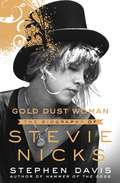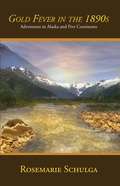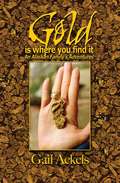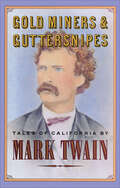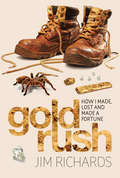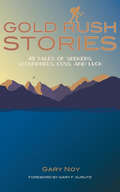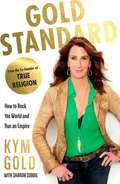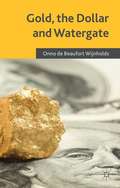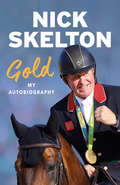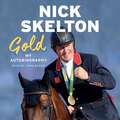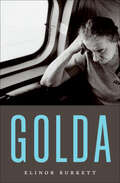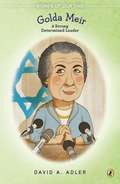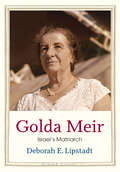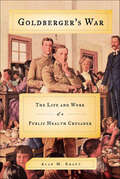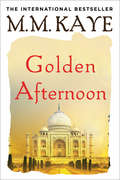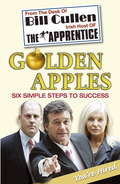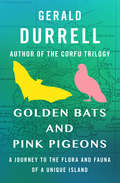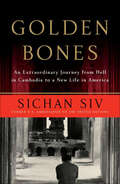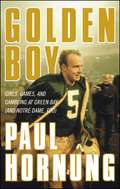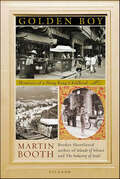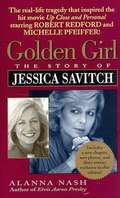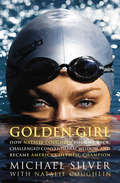- Table View
- List View
Gold Dust Woman: The Biography of Stevie Nicks
by Stephen Davis<p>Stevie Nicks is a legend of rock, but her energy and magnetism sparked new interest in this icon. At sixty-nine, she's one of the most glamorous creatures rock has known, and the rare woman who's a real rock ‘n' roller.</p> <p>Nicks' work and life are equally sexy and interesting, and Davis delves deeply into each, unearthing fresh details from new, intimate interviews and interpreting them to present a rich new portrait of the star. Just as Nicks (and Lindsey Buckingham) gave Fleetwood Mac the "shot of adrenaline" they needed to become real rock stars―according to Christine McVie―Gold Dust Woman is vibrant with stories and with a life lived large and hard.</p>
Gold Fever in the 1890s: Adventures in Alaska and Five Continents
by Rosemarie SchulgaIn a long letter to his parents, Stefan gives us an inside story of what it is like to be caught up in the 1890s Gold Rush in Alaska. We must admire the determination of this sensitive, courageous youth to overcome endless obstacles in his pursuit of his dream--gold. He lets us feel the thrill of finding his first gold nugget. Driven by gold fever, he embarks on a series of exciting adventures, from the vast wilderness of Alaska to exotic landscapes in South America, Africa, India, Australia, and back to the Klondike. Although his obsession to find gold develops into greed, his travels have a maturing effect on the callow youth. After many hardships have ravished his body and frustration of his goal to strike it rich, Stefan responds to the outcry of his neglected soul. Instead of riches he achieves spiritual peace.
Gold Is Where You Find It: An Alaskan Family's Adventures
by Gail AckelsWhy would a young high-middle class family trade the good life for a tiny one-room cabin in Alaska's wilderness? It began from a simple dream to go off and live a simpler and less complicated life. That dream set them on a course to Gold Dust Creek to become gold miners to the utter shock of family and friends. Had they gone mad? Where was the sanity in risking all for a dream that might never come true and going from Riches to Rags? Beginning from scratch, with no clue about gold mining, this courageous family ventured out, taking it a step at a time without ever knowing what to expect. There were many bumps in the road and obstacle in their path. Somehow it all worked out and reality became bigger than life and bigger even than they dared to dream. Within eleven years they made history in Alaska, developing the most advanced technology in the gold mining industry. This is the story of how they did it. Experience some of their harrowing moments with bears, armed intruders, and Mother Nature's fury, as well as hilarious encounters with nature's cute and clever critters in Alaska's awesome wilderness.
Gold Miners & Guttersnipes: Tales of California
by Mark TwainFrom a celebrated American author—collected essays, news articles, fiction, speeches, and letters centered on the nineteenth-century California gold rush. Mark Twain&’s legendary insight and wit shine throughout this new selection of his writings, the first to focus on California. As a young man, the celebrated author of Huckleberry Finn, Tom Sawyer, and other classics spent the mid-1860s in California. In this collection of essays, newspaper articles, fiction, speeches, and letters, Twain presents his notoriously unconventional views on a state booming in the wake of the gold rush. His wry humor and irreverent social commentary illuminate everything from fashion, politics, and art to earthquakes, religion, and urban crime. Drawn from hard-to-find sources as well as his ever-popular books, Gold Miners and Guttersnipes: Tales of California by Mark Twain is a fresh and distinctive assortment by one of America&’s favorite authors.
Gold Rush
by Jim RichardsWhen young Jim Richards left the army to make to chase a dream, he had no language skills, no money and no idea, just the kind of gold lust that has driven fortune hunters throughout history. And when he struck gold and diamonds in the remote rivers of Guyana, his problems and his success grew in equal measure. Jim Richards has done it all: dived for diamonds in the piranha-infested rivers of South America; discovered a fabulously rich goldmine in the Australian outback; got caught up in the world's biggest mining scam in Indonesia; and even started a gold rush in the war-torn jungles of Laos.
Gold Rush Stories: 49 Tales of Searchers, Scoundrels, Struggle and Serendipity
by Gary NoyThis volume explores the deeply human stories of the California Gold Rush generation, drawing out all the brutality, tragedy, humor, and prosperity as lived by those who experienced it. In less than ten years, more than 300,000 people made the journey to California, some from as far away as Chile and China. Many of them were dreamers seeking a better life, like Mifflin Wistar Gibbs, who eventually became the first African American judge, and Eliza Farnham, an early feminist who founded California's first association to advocate for women's civil rights. Still others were eccentrics—perhaps none more so than San Francisco's self-styled king, Norton I, Emperor of the United States. As Gold Rush Stories relates the social tumult of the world rushing in, so too does it unearth the environmental consequences of the influx, including the destructive flood of yellow ooze (known as “slickens”) produced by the widespread and relentless practice of hydraulic mining. In the hands of a native son of the Sierra, these stories and dozens more reveal the surprising and untold complexities of the Gold Rush.
Gold Standard: How to Rock the World and Run an Empire
by Kym Gold Sharon SoboilKym Gold’s mantra "never settle for a no, always look for a yes” is what led her to co-create True Religion Brand Jeans, a major retail clothing company which she sold for close to a billion dollars in 2013. In Gold Standard, she finally gives her side of the story of how the once fledgling jeans company that nobody wanted, went on to become a giant, revolutionizing player in the fashion industry. As having to constantly arm herself in the "boys club” world of the fickle fashion business, Kym went from being one of True Religion’s majority shareholders, and their lead female clothing designer, to being both served divorce papers by her partner, and having her company ripped from under her, within an hour, on Valentine’s Day in 2007. Since then she has climbed back up the ladder and catapulted into the coveted 1% of the richest Americans. In Gold Standard, Kym’s savvy business and fashion branding experience of thirty years gives a behind the scenes look into the always changing fashion industry. It also mixes in her compelling personal journey, a compassionate view for women under the pressures of holding together a career, finances, family and trying to balance it all. Kym motivates readers to throw the gold gloves on and put up a fight.
Gold, the Dollar and Watergate
by Onno de Beaufort WijnholdsThe book examines the problems that Nixon faced during his presidential term, focusing on economics but the role of politics is also highlighted. The convergence of the gold-dollar crises, oil crises and Watergate imbroglio posed a unique political and economic threat to global stability.
Gold: My Autobiography
by Nick SkeltonWith a show-jumping career spanning over forty years, Nick Skelton is a legend in the equestrian world. No other rider has won so many major competitions on so many different horses and he is as popular at Olympia and Hickstead as he is at Aachen, Geneva, Paris and Spruce Meadows. Skelton has competed in eight Olympic Games. He was part of the gold medal-winning Great Britain team at London 2012 and made history by winning the individual Olympic gold medal at Rio 2016, riding at the age of fifty-eight his beloved horse Big Star.Nick Skelton began riding at the age of eighteen months on a Welsh pony called Oxo. At the age of seventeenth in 1975, Skelton took team silver and individual gold at the Junior European Championships. He has competed many times at the European Show Jumping Championships, winning numerous medals, both individually and with the British team. In 1980 he competed in the Alternative Olympics, where he helped the British team to a silver medal. He still holds the British Show Jumping High Jump record that he set in 1978.In 2000, Skelton was forced into an early retirement after he broke his neck from a serious fall. But following an amazing recovery he came out of retirement in 2002 to compete again. Now he tells the full story of his eventful life and matchless achievements.
Gold: My Autobiography
by Nick SkeltonWith a show-jumping career spanning over forty years, Nick Skelton is a legend in the equestrian world. No other rider has won so many major competitions on so many different horses and he is as popular at Olympia and Hickstead as he is at Aachen, Geneva, Paris and Spruce Meadows. Skelton has competed in eight Olympic Games. He was part of the gold medal-winning Great Britain team at London 2012 and made history by winning the individual Olympic gold medal at Rio 2016, riding at the age of fifty-eight his beloved horse Big Star.Nick Skelton began riding at the age of eighteen months on a Welsh pony called Oxo. At the age of seventeenth in 1975, Skelton took team silver and individual gold at the Junior European Championships. He has competed many times at the European Show Jumping Championships, winning numerous medals, both individually and with the British team. In 1980 he competed in the Alternative Olympics, where he helped the British team to a silver medal. He still holds the British Show Jumping High Jump record that he set in 1978.In 2000, Skelton was forced into an early retirement after he broke his neck from a serious fall. But following an amazing recovery he came out of retirement in 2002 to compete again. Now he tells the full story of his eventful life and matchless achievements.Read by John Banks(p) Orion Publishing Group 2017
Golda
by Elinor BurkettThis biography of Israel’s first female prime minister is “a fascinating examination of Golda Meir’s public and private selves” (Library Journal).Golda Meir was the first female head of state in the Western-aligned world and one of the most influential women in modern history. A blend of Emma Goldman and Martin Luther King Jr. in the guise of a cookie-serving grandmother, her uncompromising devotion to shaping and defending a Jewish homeland against dogged enemies and skittish allies stunned political contemporaries and transformed Middle Eastern politics for decades to follow. She outmaneuvered Richard Nixon and Henry Kissinger at their own game of Realpolitik, and led Israel through a bloody war even as she eloquently pleaded for peace, carrying her nation through its most perilous hours while she herself battled cancer.In this masterful biography, author and Academy Award–winning documentarian Elinor Burkett paints a vivid portrait of a legendary woman defined by contradictions: an iron resolve coupled with magnetic charm, a kindly demeanor that disguised a stunning hard-heartedness, and a complete dedication to her country that often overwhelmed her personal relationships.“Her engaging portrait of Meir shows history with a female, though not traditionally feminine, face.” —Baltimore Sun“A solidly researched, highly readable portrait of a mesmerizing but, according to Burkett, ultimately lonely woman.” —Publishers Weekly“Leavens the heavy-duty politics with intimate portraits of her personality . . . a welcome arrival to the history shelf.” —Booklist“If anybody has written a better-researched, better-written biography [of Meir], I am unaware of it.” —St. Petersburg TimesIncludes photographs
Golda - Ek Ashant Vadal: गोल्डा - एक अशांत वादळ
by Veena Gawankarएका सामान्य रशियन ज्यू कुटुंबातील मुलगी कुटुंबासमवेत अमेरिकेला स्थलांतर करते, किशोर वयातच ती ज्यूंसाठी स्वतंत्र भूमी हवी, या विचाराने झपाटली जाते. त्या साठी ऐन विशीतच आपल्या पतीसमवेत ती अमेरिका सोडते. किबुत्झमध्ये राहून कुक्कुट पालनाचे धडे घेते, प्रसंगी बालवाडीतील मुलांचे कपडे धुऊन घरखर्च भागवते. राष्ट्र उभारणीच्या ध्येयाने प्रेरित होऊन, राजकारणात प्रवेश करते. अल्पावधीतच ती आपल्या कणखर वृत्तीनं फटकळ स्पष्टवक्तेपणानं, साध्या राहणीनं आणि सहज वणीनं आपला स्वतंत्र ठसा उमटवते, इस्रायलच्या स्वातंत्र्याच्या जाहिरनाम्यावर स्वाक्षरी करणारी ती एकमेव स्त्री. वयाची सत्तरी उलटल्यावर ती पंतप्रधान होते. आंतराष्ट्रीय पातळीवर धाडसी निर्णय घेऊन ते तडीस नेते. प्रखरपणे आपली ध्येयनिष्ठा राखते. स्वतःला स्त्रीवादी न म्हणवणारी मात्र स्रीवाद्यांसाठी रोल मॉडेल ठरलेली ही ‘गोल्डा’ - अर्थात ‘गोल्डा मेयर’.
Golda Meir: A Strong Determined Leader (Women of Our Time)
by David AdlerWhen she was a schoolgirl, Golda Meir stood on a box on a street corner and made speeches about the need for a Jewish homeland. Golda devoted her life to the land that would become Israel, moving rocks and planting trees, arguing with workers, soldiers, and kings. From her childhood in Russia and America to her years as Israel's Prime Minister, Golda worked for her dream of shalom--peace.
Golda Meir: Israel's Matriarch (Jewish Lives)
by Deborah E. LipstadtA balanced biography of Golda Meir, who was both adored and abhorred, from award-winning author Deborah E. Lipstadt &“Comprehensive. . . . Always thoughtful. . . . A nuanced account of a leader whose influence endures in the Middle East.&”—Kirkus Review Golda Meir (1898–1978) was the first and only woman to serve as prime minister of Israel. She was born in Kiev into a childhood of poverty, hunger, and antisemitism. When she was five, her father left to find work in America, and a year later the family settled in Milwaukee, Wisconsin. As a teenager she became devoted to Labor Zionism, giving street-corner speeches, and her family&’s home became a destination for Zionist emissaries. Her love for Labor Zionism was so fervent that her boyfriend, Morris Meyerson (her future husband), was often in competition with her dedication to the cause. Zionism prevailed. In 1921, Golda left America for Palestine with Morris and her sister Sheyna. Though the reality of living in Palestine was far from the dream of Zionism, Meir settled on the kibbutz Merhavia and was swiftly appointed to the Histadrut (the General Organization of Hebrew Workers in Palestine). As an ally of the Zionist David Ben-Gurion, Meir played an important role in the Yishuv, the pre-state Jewish community in Palestine; proved an almost singular ability to connect and fundraise with diaspora Jewry, particularly Americans; and served in three pivotal positions following Israel&’s independence: labor secretary of the newly formed state, foreign minister, and Israel&’s fourth prime minister. In tracing the life of Golda Meir, acclaimed author Deborah E. Lipstadt explores the history of the Yishuv and Jewish state from the 1920s through the 1973 Yom Kippur War, all while highlighting the contradictions and complexities of a person who was only the third woman to serve as a head of state in the twentieth century.
Goldberger's War: The Life and Work of a Public Health Crusader
by Alan M. KrautFor fans of Guns, Germs, and Steel, Alan M. Kraut's Goldberg's War tells the story of one doctor's courageous journey to cure deadly diseases and epidemics.Goldberger's War chronicles one of the U.S. Public Health Service's most renowned heroes--an immigrant Jew who trained as a doctor at Bellevue, became a young recruit to the federal government's health service, and ended an American plague. He did so by defying conventional wisdom, experimenting on humans, and telling the South precisely what it didn't want to hear.Kraut shows how Dr. Goldberger's life became, quite literally, the stuff of legends. On the front lines of the major public-health battles of the early 20th-century, he fought the epidemics that were then routinely sweeping the nation--typhoid, yellow fever, and the measles. After successfully confronting (and often contracting) the infectious diseases of his day, in 1914 he was assigned the mystery of pellagra, a disease whose cause and cure had eluded the world for centuries and was then afflicting tens of thousands of Americans every year, particularly in the emerging "New South." “Engrossing story of an American medical hero.” —The New England Journal of Medicine
Golden Afternoon
by M. M. KayeIn the second book of her autobiography, M. M. Kaye returns, after spending several years at a British boarding school, to India, the cherished country of her childhood. It is 1927, and nineteen-year-old Mollie makes her debut on the Delhi social scene. Feeling awkward and plain, party etiquette and society's intricate rules fluster her, but she finds comfort in her family, her Indian friends, her watercolors, and the country itself.The same humor, wisdom, and enchantment that inspired M.M. Kaye's bestselling novels fill the pages of Golden Afternoon. Kaye re-creates with perfection the nuances of a lifestyle long past and brings the people and glorious terrain of India to vivid life.
Golden Apples: Six Simple Steps to Success
by Bill CullenBill Cullen, legendary head of Renault Ireland, went from selling apples on the streets of Dublin to owning a company with an annual turnover of over $400 million. He credits much of his success to the women in his life: his mother, Mary, and his grandmother, Molly Darcy, whose fierce intelligence and homespun wisdom were a constant motivation and whose stories he told so vividly in his bestselling memoir, It's a Long Way from Penny Apples. Now Bill shares those memories, and interprets them for the twenty-first century. Under his inspirational guidance, you can transform your career and your life.
Golden Apples: Six Simple Steps to Success
by Bill CullenBill Cullen, legendary head of Renault Ireland, went from selling apples on the streets of Dublin to owning a company with an annual turnover of over $400 million. He credits much of his success to the women in his life: his mother, Mary, and his grandmother, Molly Darcy, whose fierce intelligence and homespun wisdom were a constant motivation and whose stories he told so vividly in his bestselling memoir, It's a Long Way from Penny Apples. Now Bill shares those memories, and interprets them for the twenty-first century. Under his inspirational guidance, you can transform your career and your life.
Golden Bats and Pink Pigeons: A Journey to the Flora and Fauna of a Unique Island (El\libro De Bolsillo Ser.)
by Gerald DurrellTravel to Mauritius on a quest to save endangered species with the British naturalist whose work inspired Masterpiece production The Durrells in Corfu. The green and mountainous island of Mauritius in the Indian Ocean was once the home of the ill-fated dodo. The island saw many other animals vanish from its soil, and by the 1970s, numerous species were close to being eliminated. Enter Gerald Durrell. Durrell sets out on a search for bats and pink pigeons, climbing near-vertical rock faces to find Telfair&’s skinks and Gunther&’s geckos, and swimming about coral reefs with multicolored marine life. But rounding up a collection to take back with him to his animal sanctuary in the English Channel won&’t be easy: There are many dangers awaiting him. Golden Bats and Pink Pigeons is a delightful and inspiring adventure by the author of My Family and Other Animals, among other much-loved memoirs. This ebook features an illustrated biography of Gerald Durrell including rare photos from the author&’s estate.
Golden Bones: An Extraordinary Journey from Hell in Cambodia to a New Life in America
by Sichan SivWhile the United States battled the Communists of North Vietnam in the 1960s and '70s, the neighbouring country of Cambodia was attacked from within by dictator Pol Pot and the Khmer Rouge. The Khmer Rouge imprisoned, enslaved, and murdered the educated and intellectual members of the population, resulting in the harrowing "killing fields"–rice paddies where the harvest yielded nothing but millions of skulls. Young Sichan Siv–a target since he was a university graduate–was told by his mother to run and "never give up hope!" Captured and put to work in a slave labor camp, Siv knew it was only a matter of time before he would be worked to death–or killed. With a daring escape from a logging truck and a desperate run for freedom through the jungle, including falling into a dreaded pungi pit, Siv finally came upon a colorfully dressed farmer who said, "Welcome to Thailand." He spent months teaching English in a refugee camp in Thailand while regaining his strength, eventually Siv was allowed entry into the United States. Upon his arrival in the U.S., Siv kept striving. Eventually rising to become a U.S. ambassador to the United Nations, Siv returned with great trepidation to the killing fields of Cambodia in 1992 as a senior representative of the U.S. government. It was an emotionally overwhelming visit.
Golden Boy
by Paul HornungPaul Hornung was football's "Golden Boy" -- handsome, talented, and fabulously successful. He had a great career at Notre Dame, where he won the Heisman Trophy (the only player ever to win it on a team with a losing record). He was the #1 draft pick in the NFL and went to the Green Bay Packers, a terrible team soon transformed by a new head coach, Vince Lombardi. Hornung's Packer teams would become a dynasty, and ten of his teammates (as well as Lombardi) would eventually join him in the Pro Football Hall of Fame. Hornung led the NFL in scoring from 1959 to 1961, setting a single-season scoring record in 1960 that still stands. He was Player of the Year in 1960 and 1961.Hornung always loved the good life. He had girlfriends all across the country, and he was a regular at Toots Shor's and at clubs in Chicago and Los Angeles. A frustrated Lombardi once asked him whether he wanted to be a player or a playboy, and his teammates joked about his Hollywood ambitions. On game days Hornung was always ready to play, but the night after a game -- and sometimes even the night before -- was a different story.For Hornung, the good life came at a price: his gambling cost him a year's suspension from the NFL in 1963. He accepted his punishment, refusing to implicate anyone else, but in this autobiography he reveals just how widespread gambling was in the NFL. However, on the playing field Hornung and his Packer teammates made football history. Bart Starr, Max McGee, Jim Taylor, Ray Nitschke, Jerry Kramer, Jim Ringo, Ron Kramer, Forrest Gregg, Fuzzy Thurston, Willie Davis, Herb Adderley, Willie Wood -- they're all here, and Hornung has great stories to tell about them and about some of their biggest games together.Golden Boy is a must-read for football fans, a colorful, candid slice of pigskin history from one of the game's immortal legends.
Golden Boy: Memories of a Hong Kong Childhood
by Martin BoothAt seven years old, Martin Booth found himself with all of Hong Kong at his feet. His father was posted there in 1952, and this memoir is his telling of that youth, a time when he had access to the corners of a colony normally closed to a "Gweilo," a "pale fellow" like him. His experiences were colorful and vast. Befriending rickshaw coolies and local stallholders, he learned Cantonese, sampled delicacies such as boiled water beetles and one-hundred-year-old eggs, and participated in vibrant festivals. He even entered the forbidden Kowloon Walled City, wandered into a secret lair of Triads, and visited an opium den. From the plink-plonk man with his dancing monkey to the Queen of Kowloon (a crazed tramp who may have been a Romanov), Martin Booth saw it all---but his memoir illustrates the deeper challenges he faced in his warring parents: a broad-minded mother who embraced all things Chinese and a bigoted father who was enraged by his family's interest in "going native."Martin Booth's compelling memoir, the last book he completed before dying, glows with infectious curiosity and humor and is an intimate representation of the now extinct time and place of his growing up.
Golden Codgers: Biographical Speculations
by Richard EllmannA historical survey of the literary biography, looking at the founding fathers of literary thought.
Golden Girl, The Story of Jessica Savitch
by Alanna NashShe was a commercial for the American dream. Beautiful, blond, a network news anchorwoman by the age of thirty, Jessica Savitch was a double role model--a brilliant journalistic pioneer and a Grace Kelly for the 1980s. But beneath the surface of perfection lay a shattered life. Here is a harrowing tale that explores the tragedies that haunted Savitchs personal life, including the early death of her father, the suicide of her second husband, wrenching drug dependency, neurosis, and the horrifying journey of self-sabotage and damaging personal relationships that ended in early death. Based on private diary entries, letters, and more than 300 interviews with Savitch's friends, lovers, psychiatrists, and colleagues, Golden Girl sets the record straight on both her public and private lives, and pays tribute to a woman who beat overwhelming odds to triumph in her profession.
Golden Girl: How Natalie Coughlin Fought Back, Challenged Conventional Wisdom, and Became Ame rica's Olympic Champion
by Michael Silver Natalie CoughlinThe story of Natalie Coughlin's remarkable battle back from injury and burnout to be-come America's Golden Girl—a two-time Olympic Gold Medal winner in swimming and the most decorated female athlete at the 2004 OlympicsFive years ago, Natalie Coughlin's promising swimming career was all but extinguished when a devastating shoulder injury ended her dreams for the 2000 Olympics. After becoming, at age 15, the first person ever to qualify for all 14 women's events at the U.S. Nationals, she seemed destined to follow the path of so many other young swimming stars—devoured by an oppressive training schedule.In Golden Girl, Sports Illustrated's Michael Silver—coauthor of many bestselling sports memoirs—including Dennis Rodman's, Kurt Warner's, and Jerry Rice's—tells the story of Natalie's remarkable journey back from the brink. With complete access to her family, friends, coaches, teammates, and adversaries, Silver details how she made the crucial choice to train with University of California coach Teri McKeever. Together the two, star and coach, have defied long-standing training methods, forcing the swimming community to rethink the ways in which it treats its talent. An inspirational story of a complex and courageous young athlete, Golden Girl is also a fascinating portrait of the fractious world of competitive swimming.
